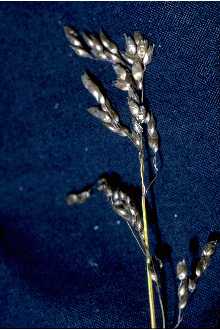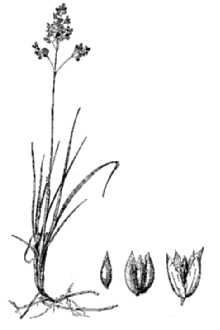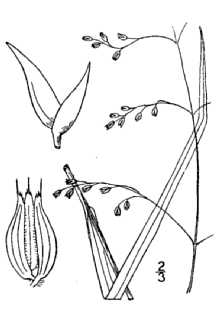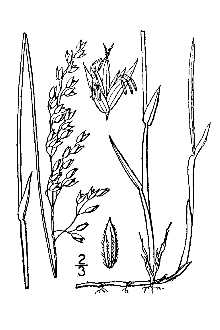Hierochloe odorata (L.) P. Beauv. var. fragrans (Willd.) K. Richt.
Scientific Name: Hierochloe odorata (L.) P. Beauv. var. fragrans (Willd.) K. Richt.

| General Information | |
|---|---|
| Usda Symbol | HIODF |
| Group | Monocot |
| Life Cycle | Perennial |
| Growth Habits | Graminoid |
| Native Locations | HIODF |
Plant Guide
Alternate Names
Vanilla grass, holy grass, Seneca grass, alpine sweetgrass , Use soil moisture sensors to measure the soil moisture of Hierochloe odorata (L.) P. Beauv. var. fragrans (Willd.) K. Richt..
Uses
Caution: Coumarin, a natural anticoagulant, gives sweetgrass its characteristic sweet smell (Lewis 1977). It has potentially toxic properties and can cause liver injury and hemorrhages. Research has shown coumarin and related compounds to be effective in reducing high-protein edemas, especially lymphodema (Leung 1980). Ethnobotanic: Sweetgrass was and still is used ceremonially through burning the dried and braided grass stems for an incense or smudge. The fragrant smoke is used for purification and to carry prayers to the Great Spirit. Hierochloë literally translates from Greek as sacred (hieros) and grass (chloë) or “holy grass” (Hitchcock et al. 1973). Indian people call sweetgrass the “grass that never dies.” Even when it is cut, it retains its fragrance and spirit (Youngbuck pers. comm. 1999). Today, sweetgrass is used inter-tribally throughout the country. Sweetgrass was used ceremonially by many tribes, including the Omaha, Ponca, Kiowa, Dakota, Lakota, Blackfeet, Cheyenne, Pawnee, and Winnebago (Jordan 1965, Moerman 1986). The Cheyenne, Blackfeet, and Lakota use sweetgrass in the Sun Dance (Kindscher 1992, Hart 1976). Sweetgrass symbolizes life’s growth for the Cheyenne (Ibid.). Sweetgrass was the most popular perfumery of the Blackfeet, who braided it and kept it with their clothes like a sachet or carried it in small bags (McClintock 1909). The Cheyenne mixed sweetgrass with pineapple weed (Matricaria matricarioides) to use as a perfume (Hart 1976). The Thompson Indians used an infusion of the plant as a wash for the hair and body (Moerman 1986). The Blackfeet and the Gros Ventre used sweetgrass as a hair rinse to achieve a lustrous shine (Hart 1976). Blackfeet women made a tea from sweetgrass that was drunk to stop vaginal bleeding after birth and to expel the placenta (Hellson 1974). Women burned sweetgrass braids after their moon time to finish the cleansing. Blackfeet men drank sweetgrass tea to treat venereal infections. Both sexes drank a tea from this plant to treat coughs and sore throats. Windburn and chapping were treated through an infusion of sweetgrass stems soaked in water or a salve of sweetgrass water and grease. The sweetgrass water was also used as an eyewash. Sweetgrass was mixed with seeds of meadow rue (Thalictrum occidentale) to make a tea to clear congested nasal passages (Kindscher 1992). The Karok of northern California used an infusion of sweetgrass to treat women who had suffered a miscarriage (Strike 1994). Pregnant women drank this infusion to arrest fetus growth. The Karok also fed sweetgrass to sick dogs. Among the Chippewa, sweetgrass was used as an incense or smudge in ceremony, as a spiritual medicine, and in basketweaving (Densmore 1974). The use of incense is more characteristic of the Plains Indians than of the Algonquian tribes (Ibid.). According to Densmore, “Men would smudge before hunting to purify body and spirit. Medicine men kept sweetgrass in the bag with their medicinal roots and herbs. Strands of sweetgrass were made into coiled Plant Materials <http://plant-materials.nrcs.usda.gov/> Plant Fact Sheet/Guide Coordination Page <http://plant-materials.nrcs.usda.gov/intranet/pfs.html> National Plant Data Center <http://npdc.usda.gov>
Status
Please consult the PLANTS Web site and your State Department of Natural Resources for this plant’s current status and wetland indicator values.
Description
General: Grass Family (Poaceae). Sweetgrass is a fragrant, rhizomatous, perennial grass that reaches a height of 7 dm. (30 in.). The stems are hollow and hairless with open sheaths. The leaf blades are flat at maturity, usually glabrous, 10-30 cm. (3.9-11.8 in.) long. The sweetgrass inflorescence is an open panicle 4-9 cm. (1.6-3.5 in.) long; the lower branches are drooping to spreading. The spikelets are three-flowered, the two lowest florets staminate (male) and the uppermost is perfect (both female and male). Sweetgrass is an early blooming plant and flowers from May to July.
Distribution
For current distribution, please consult the Plant Profile page for this species on the PLANTS Web site. Sweetgrass grows in wet meadows, low prairies, and the edges of sloughs and marshes in Minnesota, North Dakota, Montana, South Dakota, northwest Iowa, and western and central Montana. It grows from Labrador to Alaska, south to New Jersey, Indiana, Iowa, New Mexico, and Arizona. It is also native to Eurasia. Sweetgrass grows below 1830 m in California and is rare in the state, occurring in the north High Cascade Ranges and extending north (McGregor 1991).
Establishment
Adaptation: Sweetgrass is a rhizomatous perennial that is native to cooler regions of North America and Europe. It is found in moist, cool meadows, shaded stream banks, and cool mountain canyons (Dorn 1984). Caution: Due to prolific rhizome production, it can be moderately invasive. In its native habitat, sweetgrass grows primarily in wetlands and riparian areas. Due to the loss of wetland habitat throughout the United States, it is rarely appropriate to harvest wild plants. Wild harvests should be restricted to salvage sites with appropriate approvals or permits. Sweetgrass populations are declining due to harvesting for both personal and commercial use. The species is subject to over-collecting and is sensitive to grazing. Indian elders are quoted as saying “Today sweetgrass has become scarce and is hard to find” (Hart 1976). The following information on the propagation of sweetgrass is obtained from the Bridger Plant Materials Center (1996 and 1999) and Susan Winslow (1999). Propagation from Cuttings: Sweetgrass can be propagated easily from container or bare rootstock, as it produces many rhizomes. It can also be propagated from seed. However, in nature, sweetgrass is a sporadic seed producer, and germination rates are fairly low (25-30%), so propagation from seed is more difficult than from cuttings or division of plants. Handling and care requires commitment and attention to detail to maximize survival. Initially, the plants should remain in the pots for an additional 2-3 weeks after you receive them, and watering must occur every day while in the pots. This is because of the possibility of lingering transplant shock and because the soil in the pots dries out fairly quickly. The plants will continue to grow and thrive in the original containers for quite a period of time while site location and preparation efforts are finalized. Pick the sites where sweetgrass is to be transplanted carefully, and prepare the site properly before planting. It is advisable to keep the immediate planting area clear of competing vegetation, which may simply mean hand weeding around individual plants, or a mechanical means may be required. Sweetgrass grows in wetter areas in its natural habitat, and during the establishment period irrigation is likely to be required. Soil should be kept very wet to moist. For plants grown in greenhouse flats or collected from the wild, it is best to dig up and separate plants in late fall or winter (Hartman et al. 1990). This is the “quiescent” period that follows seed maturation, and leaves are senescent (dried up and brown colored). When separating plants, ensure that each “plantlet” has a rhizome or rhizome bud. Each plant should be planted in full sun in a light, loose soil. Plants should be planted on 3-foot centers; they will fill in and make solid stands of sweetgrass in one to two years. Plants need to be kept moist, and need frequent watering. Plants may need to be protected from herbivores, such as rabbits or gophers. Dogs love sweetgrass and will selectively eat the shoots and roll in the grass.
Management
After the plants have established and grown to a minimum height of 4 to 6 inches (to avoid damaging small seedlings), routinely weed and remove unwanted vegetation. This will reduce competition for light, nutrients, and water, and encourage vigorous plant growth and development. Sweetgrass prefers a moist environment, so regularly water the site. The rhizomes (underground, horizontal stems) develop early and will emerge during the first growing season. The grass will continue to spread if left unattended. The leaves will reach a length of approximately 12-15 inches and can be harvested once or twice a year. The foliage is very relaxed and it will be necessary to carefully lift the leaves and cut the stems close to the ground (leave 1 to 2 inches of plant stem). The actual number of harvests per year will depend on climatic conditions, seasonal timing, and the traditional environmental knowledge of the particular indigenous group tending the grass. Plan the final harvest (late summer in northern climes) so that there will be adequate time for the plants to prepare for the onset of cold temperatures and winter conditions. If this natural hardening-off process does not occur, it will eventually have a detrimental effect on the long-term persistent and survival of the stand. Fertilizing is not recommended in the first year of establishment, as weeds would reap the most benefit during that time. The use of a balanced, all-around, granular fertilizer is recommended after the first year. Traditional Resource Management: The following information on sweetgrass was provided by Lynn Youngbuck, who is Cherokee, Chiracahua, and Fox: 1) take only what you need, leaving the best to reproduce; 2) speak to the plant, leave an offering of tobacco or sage before harvesting; the plant will grow back two stems for every one cut; 3) we humans are another strand in life; plants sustain us and should be treated as another living being; 4) plants were taken care of by extended family groups of women; they were taken care of and watched each year for generations; and 5) materials harvested were shared and traded with the whole tribe. Cultivars, Improved and Selected Materials (and area of origin) HIOD is widely available through native plant nurseries and seed companies within its range. Contact your local Natural Resources
Conservation
Service (formerly Soil Conservation Service) office for more information. Look in the phone book under ”United States Government.” The Natural Resources Conservation Service will be listed under the subheading “Department of Agriculture.”
Seed Propagation
Propagation
Propagation
Site Preparation: The site should be prepared well in advance of planting, either late in the fall or very early in the spring. Preparation includes the following: removal of all weeds; rototilling or hand-digging so that the soil is loose and friable; raking or smoothing to a level, clump-free grade; packing or rolling to firm the surface (afterwards, only light foot imprints should be visible when walked across); and moistening the soil evenly to a depth of 2 to 3 inches (or when surface puddling is evident) with a sprinkler or hand-held spray nozzle. Seeding: Sweetgrass is a cool-season species that requires a period of cold temperatures before it will germinate from seed. Late fall, late winter, or early spring is the best time to plant the sweetgrass seed. At the time of seeding, the soil should be moistened to a depth of 1 inch. The seed should be fully ripened (very firm when squeezed between fingernails or when clipped with a fingernail clipper) and free of debris. Sweetgrass seed is very small at approximately 1.1 million seeds per pound. Depending on the amount of seed available and the plant density desired, the seed can be dribbled in rows at a rate of up to 25 seeds per linear foot, or broadcast at 50 seeds per square foot. This may optimally result in 6 plants per row and/or 13 plants per square foot (seed germination tests have averaged 25-30%). Planting depth should not exceed 0.25 to 0.5 inches. It is very important after seed placement that the area be re-rolled or packed to ensure satisfactory seed-to-soil contact. The tiny seed can be easily washed away, so follow planting immediately with a light watering. Keep the area moist until seedling emergence, in about 10-14 days. In soils (clayey) that are prone to crusting, subsequent periodic, short-duration watering may be necessary.
Fact Sheet
Alternate Names
The plant “sweetgrass” consists of two different taxa: Hierochloe odorata (L.) Beauv. HIOD and Hierochloe hirta (Schrank) var. arctica (J.Presl) G.Weim. HIHIA; vanilla grass, holy grass, Seneca grass, alpine sweetgrass
Uses
Cultural: The cultural uses of sweetgrass include ceremonial incense, perfume, hair wash, bedding, basketry, dermatological aid, cold remedy, cough medicine, eyewash, febrifuge, respiratory aid, analgesic, insecticide, veterinary aid, decoration and adornment. Because of the sweet, vanilla-like fragrance that develops once the plant has been harvested and begins to dry the use of sweetgrass as incense and fragrance is fairly ubiquitous among Native American tribes. The longer leaves are often braided and burned for religious and peace ceremonies, to invoke good power, and for various other rituals of cultural significance. In addition, sweetgrass has been utilized for several medicinal and cosmetic purposes. Whether alone, as adornment and perfume, or soaked in water for tea and other solutions the therapeutic applications of sweetgrass are scattered throughout the tribes. Another traditional use of this invoke good power, and for various other rituals of cultural significance. In addition, sweetgrass has been utilized for several medicinal and cosmetic purposes. Whether alone, as adornment and perfume, or soaked in water for tea and other solutions the therapeutic applications of sweetgrass are scattered throughout the tribes. Another traditional use of this plant, particularly among the people of the Great Lakes and Northeast, is in handicrafts. Sweetgrass is often employed to craft or decorate baskets, bowls, trays and mats.
Status
Please consult the PLANTS Web site and your State Department of Natural Resources for this plant’s current status (e.g. threatened or endangered species, state noxious status, and wetland indicator values).
Description
Sweetgrass is a native perennial grass. The culms are semi-erect, up to 30 inches tall and arise from slender, creeping rhizomes. Leaves are few, rough-edged and have shiny, hairless undersides. Often it has a reddish-purple color near the base of the plant. The highly prized longer leaves that grow on sterile shoots reach 18+ inches in length. The inflorescence is an open, pyramid-shaped, golden brown panicle with slender branches. Spikelets have 3 florets with awnless lemmas; glumes are thin, translucent and nearly equal in length. The fruit is a caryopsis. Robert H. Mohlenbrock USDA NRCS 1992 Western Wetland Flora @ USDA NRCS PLANTS
Adaptation and Distribution
Distribution
Distribution
Both taxa of sweetgrass are circumpolar, and native to both the western and eastern hemispheres. In North America their extensive range traverses the northern regions from Alaska to Newfoundland, moving down to New England, across the Great Lakes region and the upper Midwest to Oregon, and into the Southwest. Sweetgrass usually inhabits moist ground on shores (fresh or brackish), meadows, low prairies, at the edges of woods, bogs and marshes. Normally, it is not found in pure stands but among other grasses and shrubs in mid-successional communities. For a current distribution map, please consult the Plant Profile page for this species on the PLANTS Website.
Establishment
Sweetgrass spreads vigorously by often-deep creeping rhizomes, In the spring these rhizomes produce inconspicuous fruiting stems with sparse, short leaves, Longer leaves develop later from separate sterile basal shoots, Although sweetgrass can reproduce by seed, it is mostly infertile, producing few seedheads that contain few seeds, Sweetgrass is extremely cold hardy, Use soil moisture sensors to measure the soil moisture of Hierochloe odorata (L.) P. Beauv. var. fragrans (Willd.) K. Richt.., It will go dormant in cold weather and resprout once ground temperatures reach 40 oF, For the Great Lakes, Northeastern and Midwestern regions flowering begins in the spring, Sweetgrass development from seed is very slow, This coupled with the infertile nature of the plant explains why plant division is the most successful method of reproducing sweetgrass, Dividing a plant is accomplished by separating the individual propagules that have developed from the rhizomes of a spreading plant, Each propagule can then be placed in a container for further separation or future planting, Newly separated plants will do best if placed in the shade for 2–3 weeks while their roots establish, After this, transplant at 1-foot spacings into areas of partial shade to full sun,
Plant Traits
Growth Requirements
| Temperature, Minimum (°F) | -38 |
|---|---|
| Adapted to Coarse Textured Soils | Yes |
| Adapted to Fine Textured Soils | No |
| Adapted to Medium Textured Soils | Yes |
| Anaerobic Tolerance | Medium |
| CaCO3 Tolerance | Medium |
| Cold Stratification Required | No |
| Drought Tolerance | Low |
| Fertility Requirement | Medium |
| Fire Tolerance | High |
| Frost Free Days, Minimum | 130 |
| Hedge Tolerance | None |
| Moisture Use | High |
| pH, Maximum | 7.4 |
| pH, Minimum | 5.7 |
| Precipitation, Maximum | 50 |
| Precipitation, Minimum | 16 |
| Root Depth, Minimum (inches) | 12 |
| Salinity Tolerance | Medium |
| Shade Tolerance | Intermediate |
Morphology/Physiology
| After Harvest Regrowth Rate | Moderate |
|---|---|
| Toxicity | None |
| Shape and Orientation | Semi-Erect |
| Nitrogen Fixation | None |
| Resprout Ability | No |
| Active Growth Period | Spring, Summer, Fall |
| Bloat | None |
| C:N Ratio | Medium |
| Coppice Potential | No |
| Fall Conspicuous | No |
| Fire Resistant | No |
| Flower Color | Yellow |
| Flower Conspicuous | No |
| Foliage Color | Gray-Green |
| Foliage Porosity Summer | Porous |
| Foliage Texture | Medium |
| Low Growing Grass | No |
| Lifespan | Moderate |
| Leaf Retention | No |
| Known Allelopath | No |
| Height, Mature (feet) | 2.0 |
| Growth Rate | Moderate |
| Growth Form | Bunch |
| Fruit/Seed Conspicuous | No |
| Fruit/Seed Color | Black |
| Foliage Porosity Winter | Porous |
Reproduction
| Vegetative Spread Rate | None |
|---|---|
| Small Grain | No |
| Seedling Vigor | Low |
| Seed Spread Rate | Slow |
| Seed per Pound | 110000 |
| Fruit/Seed Persistence | No |
| Propagated by Tubers | No |
| Propagated by Sprigs | No |
| Propagated by Sod | No |
| Propagated by Seed | Yes |
| Propagated by Corm | No |
| Propagated by Container | No |
| Propagated by Bulb | No |
| Propagated by Bare Root | No |
| Fruit/Seed Period End | Fall |
| Fruit/Seed Period Begin | Summer |
| Fruit/Seed Abundance | High |
| Commercial Availability | Routinely Available |
| Bloom Period | Mid Summer |
| Propagated by Cuttings | No |
Suitability/Use
| Veneer Product | No |
|---|---|
| Pulpwood Product | No |
| Protein Potential | Low |
| Post Product | No |
| Palatable Human | No |
| Palatable Graze Animal | Low |
| Palatable Browse Animal | Medium |
| Nursery Stock Product | No |
| Naval Store Product | No |
| Lumber Product | No |
| Fodder Product | Yes |
| Christmas Tree Product | No |
| Berry/Nut/Seed Product | No |



